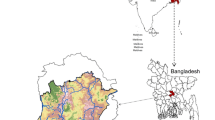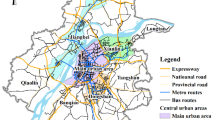Abstract
As a public service facility that provides relief, resettlement, and evacuation services to disaster-affected people, emergency shelters play a vital role in helping people cope with disaster events. The measurement of spatial accessibility of existing emergency shelters is a key task in improving emergency shelter services and minimizing property losses and deaths. In this study, considering the differences in emergency shelters’ service capacities and population distribution, we developed a two-step floating catchment area (2SFCA) method with a variable service radius and evacuation radius to describe emergency shelter accessibility in Lanzhou’s core area and compared with the traditional 2SFCA method. Furthermore, we used bivariate local Moran's I to identify the spatial relationships between emergency shelter accessibility and population density. The results show that the traditional 2SFCA method underestimates accessibility in densely populated areas with dispersed emergency shelters. Shelter accessibility in Lanzhou’s core area is unevenly distributed, with the lowest levels of accessibility in densely populated areas. There is an obvious spatial mismatch between the accessibility of emergency shelters and the population density, and the central and western part of Chengguan has a serious shortage of emergency shelters. This study provides important information for the planning and construction of emergency shelters.








Similar content being viewed by others
References
Anhorn, J., & Khazai, B. (2015). Open space suitability analysis for emergency shelter after an earthquake. Natural Hazards and Earth System Sciences, 15(4), 789–803. https://doi.org/10.5194/nhess-15-789-2015.
Chang, H.-S., & Liao, C.-H. (2014). Planning emergency shelter locations based on evacuation behavior. Natural Hazards, 76(3), 1551–1571. https://doi.org/10.1007/s11069-014-1557-x.
Chen, W., Fang, Y., Zhai, Q., Wang, W., & Zhang, Y. (2020). Assessing emergency shelter demand using POI data and evacuation simulation. ISPRS International Journal of Geo-Information, 9(1), 41. https://doi.org/10.3390/ijgi9010041.
Chen, X., & Jia, P. (2019). A comparative analysis of accessibility measures by the two-step floating catchment area (2SFCA) method. International Journal of Geographical Information Science, 33(9), 1739–1758. https://doi.org/10.1080/13658816.2019.1591415.
Chen, W., Zhai, G., Fan, C., Jin, W., & Xie, Y. (2016). A planning framework based on system theory and GIS for urban emergency shelter system: A case of Guangzhou, China. Human and Ecological Risk Assessment: An International Journal, 23(3), 441–456. https://doi.org/10.1080/10807039.2016.1185692.
Cheng, G., Zeng, X., Duan, L., Lu, X., Sun, H., Jiang, T., & Li, Y. (2016). Spatial difference analysis for accessibility to high level hospitals based on travel time in Shenzhen, China. Habitat International, 53, 485–494. https://doi.org/10.1016/j.habitatint.2015.12.023.
Dai, D. (2010). Black residential segregation, disparities in spatial access to health care facilities, and late-stage breast cancer diagnosis in metropolitan Detroit. Health Place, 16(5), 1038–1052. https://doi.org/10.1016/j.healthplace.2010.06.012.
Dai, D. (2011). Racial/ethnic and socioeconomic disparities in urban green space accessibility: Where to intervene? Landscape and Urban Planning, 102(4), 234–244. https://doi.org/10.1016/j.landurbplan.2011.05.002.
Fraser, S. A., Wood, N. J., Johnston, D. M., Leonard, G. S., Greening, P. D., & Rossetto, T. (2014). Variable population exposure and distributed travel speeds in least-cost tsunami evacuation modelling. Natural Hazards and Earth System Sciences, 14(11), 2975–2991. https://doi.org/10.5194/nhess-14-2975-2014.
Guo, S., Song, C., Pei, T., Liu, Y., Ma, T., Du, Y., et al. (2019). Accessibility to urban parks for elderly residents: Perspectives from mobile phone data. Landscape and Urban Planning, 191, 103642. https://doi.org/10.1016/j.landurbplan.2019.103642.
Hu, Q.-M., Zhao, L., Li, H., & Huang, R. (2019). Integrated design of emergency shelter and medical networks considering diurnal population shifts in urban areas. IISE Transactions, 51(6), 614–637. https://doi.org/10.1080/24725854.2018.1519744.
Hu, S., Song, W., Li, C., & Lu, J. (2020). A multi-mode Gaussian-based two-step floating catchment area method for measuring accessibility of urban parks. Cities, 105, 102815. https://doi.org/10.1016/j.cities.2020.102815.
Jiang, X., Song, J., Lin, Y., & Gong, Y. (2018). A practical approach to constructing hierarchical networks for urban hazard mitigation planning using GIS: The case of Futian, Shenzhen. International Journal of Disaster Risk Reduction, 28, 629–639. https://doi.org/10.1016/j.ijdrr.2018.01.014.
Jin, M., Liu, L., Tong, G., & Y., & Liu, Y. . (2019). Evaluating the Spatial Accessibility and Distribution Balance of Multi-Level Medical Service Facilities. International Journal of Environmental Research and Public Health, 16(7), 1150. https://doi.org/10.3390/ijerph16071150.
Joseph, A. E., & Bantock, P. R. (1982). Measuring potential physical accessibility to general practitioners in rural areas: A method and case study. Social Science & Medicine, 16(1), 85–90. https://doi.org/10.1016/0277-9536(82)90428-2.
Kılcı, F., Kara, B. Y., & Bozkaya, B. (2015). Locating temporary shelter areas after an earthquake: A case for Turkey. European Journal of Operational Research, 243(1), 323–332. https://doi.org/10.1016/j.ejor.2014.11.035.
Li, H., Zhao, L., Huang, R., & Hu, Q. (2017). Hierarchical earthquake shelter planning in urban areas: A case for Shanghai in China. International Journal of Disaster Risk Reduction, 22, 431–446. https://doi.org/10.1016/j.ijdrr.2017.01.007.
Li, X., Xiu, C., Wei, Y., & He, H. S. (2020). Evaluating Methodology for the Service Extent of Refugee Parks in Changchun, China. Sustainability, 12(14), 5715. https://doi.org/10.3390/su12145715.
Liu, Q., Ruan, X., & Shi, P. (2011). Selection of emergency shelter sites for seismic disasters in mountainous regions: Lessons from the 2008 Wenchuan Ms 8.0 Earthquake, China. Journal of Asian Earth Sciences, 40(4), 926–934. https://doi.org/10.1016/j.jseaes.2010.07.014.
Liu, Y., Jing, Y., Zhang, L., Li, J., & Yin, C. (2017). Assessing spatial accessibility of public and private residential aged care facilities: A case study in Wuhan, Central China. ISPRS International Journal of Geo-Information, 6(10), 304. https://doi.org/10.3390/ijgi6100304.
Lu, Y., & Li, S. (2019). Spatial accessibility of indoor emergency shelters based on improved G2SFCA in Shenzhen City. Geomatics and Information Science of Wuhan University, 44(9), 1391–1398. https://doi.org/10.13203/j.whugis20180456. (In Chinese)
Luo, J. (2014). Integrating the huff model and floating catchment area methods to analyze spatial access to healthcare services. Transactions in GIS, 18(3), 436–448. https://doi.org/10.1111/tgis.12096.
Luo, W., & Qi, Y. (2009). An enhanced two-step floating catchment area (E2SFCA) method for measuring spatial accessibility to primary care physicians. Health Place, 15(4), 1100–1107. https://doi.org/10.1016/j.healthplace.2009.06.002.
Luo, W., & Wang, F. (2003). Measures of spatial accessibility to health care in a GIS environment: Synthesis and a case study in the Chicago region. Environment and Planning B: Planning and Design, 30(6), 865–884. https://doi.org/10.1068/b29120.
Luo, W., & Whippo, T. (2012). Variable catchment sizes for the two-step floating catchment area (2SFCA) method. Health Place, 18(4), 789–795. https://doi.org/10.1016/j.healthplace.2012.04.002.
Lyu, H.-M., Shen, J., & Arulrajah, A. (2018). Assessment of geohazards and preventative countermeasures using AHP incorporated with GIS in Lanzhou, China. Sustainability, 10(2), 304. https://doi.org/10.3390/su10020304.
Masuya, A., Dewan, A., & Corner, R. J. (2015). Population evacuation: Evaluating spatial distribution of flood shelters and vulnerable residential units in Dhaka with geographic information systems. Natural Hazards, 78(3), 1859–1882. https://doi.org/10.1007/s11069-015-1802-y.
Ministry of Construction of China. (2007). Standard for urban planning on earthquake resistance and hazardous prevention (GB 50413–2007). Beijing: China Architecture and Building Press. ((In Chinese)).
Ministry of Construction of China. (2015). Code for design of disasters mitigation emergency congregate shelter (GB 51143-2015). Beijing: China Architecture and Building Press. ((In Chinese)).
Nakamura, T., Nakamura, A., Mukuda, K., Harada, M., & Kotani, K. (2017). Potential accessibility scores for hospital care in a province of Japan: GIS-based ecological study of the two-step floating catchment area method and the number of neighborhood hospitals. BMC Health Services Research, 17(1), 438. https://doi.org/10.1186/s12913-017-2367-0.
Neutens, T., Schwanen, T., Witlox, F., & De Maeyer, P. (2010). Equity of urban service delivery: A comparison of different accessibility measures. Environment and Planning A: Economy and Space, 42(7), 1613–1635. https://doi.org/10.1068/a4230.
Ni, J., Wang, J., Rui, Y., Qian, T., & Wang, J. (2015). An enhanced variable two-step floating catchment area method for measuring spatial accessibility to residential care facilities in Nanjing. International Journal of Environmental Research and Public Health, 12(11), 14490–14504. https://doi.org/10.3390/ijerph121114490.
Radke, J., & Mu, L. (2000). Spatial decompositions, modeling and mapping service regions to predict access to social programs. Geographic Information Sciences, 6(2), 105–112. https://doi.org/10.1080/10824000009480538.
Shi, L., Halik, Ü., Abliz, A., Mamat, Z., & Welp, M. (2020). Urban green space accessibility and distribution equity in an arid Oasis City: Urumqi, China. Forests, 11(6), 690. https://doi.org/10.3390/f11060690.
Shiode, N., Morita, M., Shiode, S., & Okunuki, K.-I. (2014). Urban and rural geographies of aging: a local spatial correlation analysis of aging population measures. Urban Geography, 35(4), 608–628. https://doi.org/10.1080/02723638.2014.905256.
Tahmasbi, B., Mansourianfar, M. H., Haghshenas, H., & Kim, I. (2019). Multimodal accessibility-based equity assessment of urban public facilities distribution. Sustainable Cities and Society, 49, 101633. https://doi.org/10.1016/j.scs.2019.101633.
Takabatake, T., Shibayama, T., Esteban, M., Ishii, H., & Hamano, G. (2017). Simulated tsunami evacuation behavior of local residents and visitors in Kamakura, Japan. International Journal of Disaster Risk Reduction, 23, 1–14. https://doi.org/10.1016/j.ijdrr.2017.04.003.
Tang, B., Wang, D., Song, Y., Qiu, J., Yan, Y., & Zhang, Z. (2017). Research on the Emergency Shelter Accessibility in Urban Communities. Journal of Risk Analysis and Crisis Response, 7(4), 230–237. https://doi.org/10.2991/jrarc.2017.7.4.5.
Tao, Z., Cheng, Y., Du, S., Feng, L., & Wang, S. (2020). Accessibility to delivery care in Hubei Province, China. Social Science & Medicine, 260, 113186. https://doi.org/10.1016/j.socscimed.2020.113186.
Wang, F. (2012). Measurement, optimization, and impact of health care accessibility: A methodological review. Annals of the Association of American Geographers, 102(5), 1104–1112. https://doi.org/10.1080/00045608.2012.657146.
Wang, X., Yang, H., Duan, Z., & Pan, J. (2018). Spatial accessibility of primary health care in China: A case study in Sichuan Province. Social Science & Medicine, 209, 14–24. https://doi.org/10.1016/j.socscimed.2018.05.023.
Wu, C., Ye, X., Du, Q., & Luo, P. (2017). Spatial effects of accessibility to parks on housing prices in Shenzhen, China. Habitat International, 63, 45–54. https://doi.org/10.1016/j.habitatint.2017.03.010.
Wu, J., Chen, H., Wang, H., He, Q., & Zhou, K. (2020). Will the opening community policy improve the equity of green accessibility and in what ways?—Response based on a 2-step floating catchment area method and genetic algorithm. Journal of Cleaner Production, 263, 121454. https://doi.org/10.1016/j.jclepro.2020.121454.
Xia, Z., Li, H., Chen, Y., & Yu, W. (2019). Integrating spatial and non-spatial dimensions to measure urban fire service access. ISPRS International Journal of Geo-Information, 8(3), 138. https://doi.org/10.3390/ijgi8030138.
Yang, N., Chen, S., Hu, W., Wu, Z., & Chao, Y. (2016). Spatial distribution balance analysis of hospitals in Wuhan. International Journal of Environmental Research and Public Health, 13(10), 971. https://doi.org/10.3390/ijerph13100971.
Ye, M., Wang, J., Huang, J., Xu, S., & Chen, Z. (2011). Methodology and its application for community-scale evacuation planning against earthquake disaster. Natural Hazards, 61(3), 881–892. https://doi.org/10.1007/s11069-011-9803-y.
Yuan, H., Gao, X., & Qi, W. (2019). Fine-scale spatiotemporal analysis of population vulnerability to earthquake disasters: Theoretical models and application to cities. Sustainability, 11(7), 2149. https://doi.org/10.3390/su11072149.
Zhang, K., & Zhang, S. (2019). Accessibility analysis of protestant churches in Shanghai. China: GeoJournal. https://doi.org/10.1007/s10708-019-10089-z.
Zhang, X. H., Lei, C. F., & Li, H. F. (2013). Study on natural disaster prevention countermeasures for Western Valley City from the perspective of city planning: A case of Lanzhou City. Applied Mechanics and Materials, 409, 827–832. https://doi.org/10.4028/www.scientific.net/AMM.409-410.827.
Zhou, A., Zhang, J., & Fu, X. (2014). On the spatial distribution of the urban-emergency shelter in Beijing downtown areas. Journal of Safety and Environment, 14(3), 151–156. https://doi.org/10.13637/j.issn.1009-6094.2014.03.034 ((In Chinese)).
Zhu, X., Tong, Z., Liu, X., Li, X., Lin, P., & Wang, T. (2018). An improved two-step floating catchment area method for evaluating spatial accessibility to urban emergency shelters. Sustainability, 10(7), 2180. https://doi.org/10.3390/su10072180.
Funding
This research was supported by the Fundamental Research Funds in Institute of Earthquake Science China Earthquake Administration (Grant Numbers 2015IESLZ06 and 2020IESLZ05).
Author information
Authors and Affiliations
Corresponding author
Ethics declarations
Conflict of interest
The authors declare that there are no conflict of interest.
Additional information
Publisher's Note
Springer Nature remains neutral with regard to jurisdictional claims in published maps and institutional affiliations.
Rights and permissions
About this article
Cite this article
Su, H., Chen, W. & Cheng, M. Using the variable two-step floating catchment area method to measure the potential spatial accessibility of urban emergency shelters. GeoJournal 87, 2625–2639 (2022). https://doi.org/10.1007/s10708-021-10389-3
Accepted:
Published:
Issue Date:
DOI: https://doi.org/10.1007/s10708-021-10389-3




